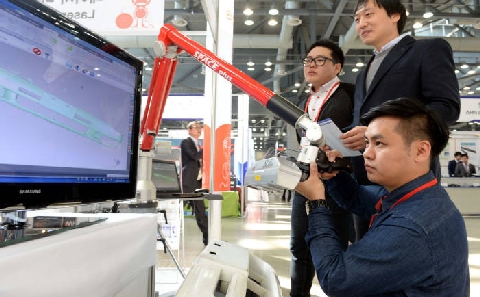With application of carbon composite materials to reduce the weight of car body emerging as a topic of conversion in the automotive industry, Korea’s carmakers are accelerating R&D in the related fields.
Although still in its infancy compared to the advanced automotive countries like Germany, Korea’s automotive industry is forecast to develop commercial-level technologies for some automotive parts as early as the second half of next year.
Korea Industrial Complex Corporation (KICOX) Ulran Branch and 14 companies and institutes participating in Ulsan Automotive Carbon Composite Materials and Parts Cluster set up a joint exhibition hall at Korea Auto-parts and Auto-related Industries Show (KOAA) started on the 28th in KINTEX of Goyang-si, Gyeonggi-do and introduced their R&D strategies. This is the first time a large number of companies and institutes participate under the theme of carbon composite materials in this exhibition, which is held for the 11th time this year.
In addition to 11 automotive parts makers including Webasto DONGHEE and Dongkook Ind., universities and research centers, such as Ulsan National Institute of Science and Technology and Korea Institute of Materials Science, are participating in the cluster. This cluster started a research on applying carbon composite materials to the car sunroof and front module carrier by obtaining a government subsidy of KRW 1.4 billion in September. The goal is to secure technological power in the first year of project and to manufacture and verify prototypes in the second year.
Carbon composite material is higher in strength and lighter in weight than the existing metallic materials, such as high strength steel or aluminum. Applied to a sunroof frame, it almost halves the weight and increases strength by about five times. When used in a front module carrier, carbon composite material is expected to improve durability by two ? three times and weight reduction effect by five times.
Japan’s Toyota first applied carbon fiber reinforced plastics (CFRP) to a high-performance sports car in 2010. Through CFRP application, the weight of the vehicle was reduced by approximately 100kg than an aluminum body. Germany’s BMW also used the same material on i3 electric vehicle and made the frame light enough to be lighted up by two adults with bear hands.
In Korea, Hyosung Group succeeded in developing a high strength carbon fiber last year. However, Korea is still in a beginning stage in terms of the material application to automotive parts. Parts makers started the related research and carmakers are also reviewing introduction of the materials. However, mass-production and application references have not been produced yet. Compared to steel, production cost using carbon composite materials is higher by ten times. As much as so, mass-production technology development is urgently required.
“We are trying out various techniques, such as injection and pressing, to develop a panoramic sunroof using carbon composite materials,” said a Webasto DONGHEE source. “We will be able to produce an outcome as early as the second half of next year.”
“Our ultimate goal is to apply carbon composite materials for 10 ? 30% of the vehicle body,” said a KICOX insider. “As we have started R&D, we will examine project expansion\ following the second year assessment.”
The event was attended by around 350 domestic and international automobile-related companies including 43 foreign companies. To be held until the 30th, this exhibition is expected to draw in approximately 20,000 visitors including overseas buyers.
Song Joon-yeong | songjy@etnews.com
국내 자동차 부품업계, 탄소복합소재 개발 `러시`
<자동차와 연관된 산업을 한눈에 조망할 수 있는 ‘한국자동차부품산업전시회(KOAA)’가 28일 경기도 일산 킨텍스에서 열렸다. 43개 해외 업체를 포함해 총 350여 국내외 자동차 관련업체가 참가한 가운데 레이져디자인시스템 부스에서 도면 없이 제품만으로 3D 모델링 데이터를 제공하는 과정을 시연하고 있다. 박지호기자 jihopress@etnews.com>
차체 경량화를 위한 탄소복합소재 적용이 자동차 업계 화두로 떠오른 가운데 우리나라 업계도 관련 연구개발(R&D)에 속도를 낸다.
독일 등 자동차 선진국에 비하면 걸음마 수준이지만 이르면 내년 하반기 일부 부품에서 상용 기술이 개발될 전망이다.
한국산업단지공단 울산지사, 울산 자동차용 탄소복합소재부품 클러스터 참여 기관?기업 14곳은 28일 경기도 고양시 킨텍스에서 열린 ‘한국자동차부품산업전시회(KOAA)’에 공동 전시관을 꾸리고 R&D 전략을 소개했다. 올해 11회째를 맞는 이 전시회에 탄소복합소재를 주제로 기업과 기관이 대거 참여한 것은 이번이 처음이다.
클러스터에는 베바스트 동희, 동국실업 등 자동차 부품 제조사 11개뿐만 아니라 울산과학기술대학교(UNIST), 한국기계연구원 부설 재료연구소 등 대학과 연구기관도 참여한다. 지난 9월 정부 예산 14억원을 지원받아 자동차 선루프와 프론트 모듈 캐리어에 탄소복합소재를 적용하는 연구를 시작했다. 사업 1차년도에 기술력을 확보하고 2차년도에 시제품을 제작해 검증하는 것이 목표다.
탄소복합소재는 고장력 강판이나 알루미늄 등 기존 금속 소재에 비해 강도는 뛰어나고 무게는 가볍다. 선루프 프레임에 적용하면 무게는 절반가량 줄이고 강도는 다섯 배가량 높일 수 있다. 프런트 모듈 캐리어에 적용하면 경량화 효과는 다섯 배, 내구성은 두세 배가량 증가할 것으로 예상된다.
일본 도요타는 2010년 고성능 스포츠카에 처음으로 탄소섬유강화수지(CFRP)를 적용해 알루미늄 차체에 비해 100㎏가량 무게를 줄였다. 독일 BMW도 i3 전기자동차에 같은 소재를 사용해 차체 프레임 무게를 성인 두 명이 맨손으로 들 수 있는 수준으로 만들었다.
우리나라는 지난해 효성그룹이 고강도 탄소섬유 개발에 성공했지만 자동차 부품 분야 적용은 걸음마 수준이다. 부품 제조사들이 관련 연구를 시작했고 완성차 업체도 도입을 검토하고 있지만 양산과 적용 사례가 없다. 특히 생산 단가가 철강의 열 배 수준으로 비싸 양산 기술 개발이 절실한 상황이다.
베바스토 동희 관계자는 “탄소복합소재로 만든 파노라마 선루프 개발을 위해 사출과 프레스 등 다양한 공법을 시도 중”이라며 “이르면 내년 하반기 결과물을 내놓을 수 있을 것”이라고 밝혔다.
산업단지공단 관계자는 “궁극적으로는 차체 10~30%에 탄소복합소재를 적용하는 것이 목표”라며 “R&D 첫발을 뗀 만큼 2년 과제 평가 후 사업 확대를 검토할 계획”이라고 말했다.
이날 행사에는 43개 해외 업체를 포함해 350여 국내외 자동차 관련 기업이 참가했다. 30일까지 이어지는 전시회에 해외 바이어를 포함한 업계 관계자 2만여명이 방문할 것으로 예상된다.
송준영기자 | songjy@etnews.com
